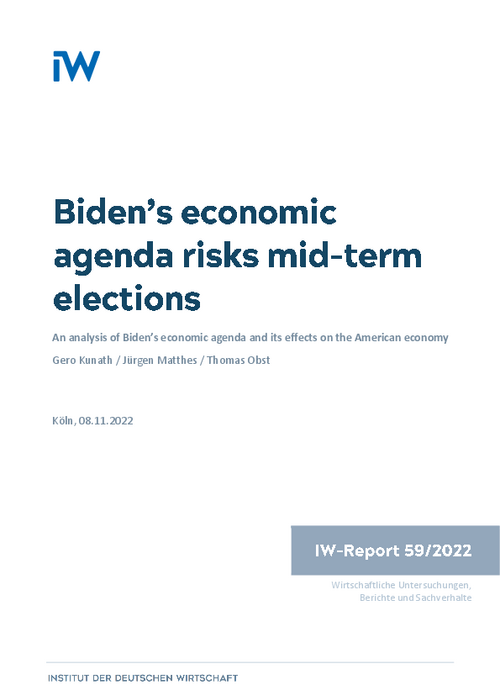President Joe Biden faces some political and economic headwinds in the upcoming U.S. midterm elections this year. Current economic challenges include historically high inflation rates and signs of an impending recession.

Biden’s economic agenda risks mid-term elections

President Joe Biden faces some political and economic headwinds in the upcoming U.S. midterm elections this year. Current economic challenges include historically high inflation rates and signs of an impending recession.
Besides issues such as climate change, gun control, abortion, or immigration the number one issue for U.S. voters appears to be inflation. In this context, polls show that most Americans disapprove of Biden’s handling of the economy because of the cost-of-living crisis that developed in 2022. The Biden administration has initiated a comprehensive economic agenda. Democrats have succeeded in gaining bipartisan support pushing through substantial legislation within the first two years. Overall, Biden’s “Build Back Better” agenda, also known as Bidenomics, rests on five key pillars: (1) American Rescue Plan to deal with the effects of the Covid pandemic, (2) Infrastructure Investment and Jobs Act to strengthen the economic base, (3) Build Back Better Act which culminated in the Inflation Reduction Act to tackle climate change and strengthen social security, (4) CHIPS and Science Act to gain leverage in international competition, and (5) the Buy American regulations to protect domestic industry. In total, these fiscal policies will spend roughly $3.8 trillion over the next decade. The first two programs have already injected substantial amounts of money into the U.S. economy. Increasing aggregate demand has led to strong economic growth in 2021, a tightening labor market with historically low unemployment rates, but also a significant increase in inflation and a subsequent reversal of the Fed’s monetary policy in 2022.
This paper gives a critical overview of the political and economic environment the Democratic party is facing in the November 8 midterm elections. We analyze the economic effects of Bidenomics and quantify the effects of the vast fiscal programs on the U.S. economy discussing the issue of inflationary pressures of the expansionary fiscal policy programs. The analysis shows that while the American Rescue Plan has substantially increased aggregate demand in the U.S. economy and stimulated export demand for countries like Germany it has likely added to the current issue of high inflation rates, e.g., caused by core inflation items rather than exogenous energy shocks as in Europe. However, while programs such as the Inflation Reduction Act do not add further substantial stimulus on an annual basis all these programs contain a transformative element that possibly makes it attractive for U.S. companies to invest in new technologies, infrastructure, and green energy networks. This improves the capital stock, making positive longer-term positive effects on potential output more likely.
Biden, however, faces the risk that the economy is too strong for its own good. When the vast fiscal programs were enacted, secondary effects such as inflation were raised by some economists. It seemed that unlike the 2008 financial crisis, the U.S. government feared doing too little to help households and businesses. Since the U.S. system does not have strong automatic stabilizers, the preferred approach was to spread helicopter money to households through generous means such as pay-checks. This large-scale demand stimulus, in an environment of a severely restrained supply side and falling potential output, seems to have put a lot of pressure on the U.S. economy, putting the midterm elections for the Democrats at risk. Voters feel inflationary pressures every day and may not perceive the Built-Back agenda to be directly beneficial to them. This constitutes a significant threat for Biden, e.g., in the important Rust Belt states. Trump promised these states an economic renaissance, persuading them to vote for him. During his presidency, however, he did little for these states. Biden, in contrast, has provided extensive economic support to the region and initiated a structural transformation that has the potential to turn it into a future U.S. industrial heartland. However, the current economic turmoil could cloud voters’ assessments of the Rust Belt states and cost him crucial votes.

Biden’s economic agenda risks mid-term elections

More on the topic
Not so Different?: Dependency of the German and Italian Industry on China Intermediate Inputs
On average the German and Italian industry display a very similar intermediate input dependence on China, whether accounting for domestic inputs or not.
IW
China’s Trade Surplus – Implications for the World and for Europe
China’s merchandise trade surplus has reached an all-time high and is likely to rise further. A key driver appears to be a policy push to further bolster Chinese domestic manufacturing production, implying the danger of significant overcapacities.
IW